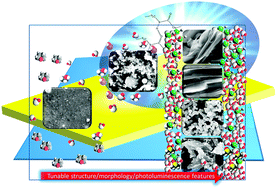Di-amidosils with tunable structure, morphology and emission quantum yield: the role of hydrogen bonding†
Abstract
Tailoring of the structure (from amorphous to highly ordered lamellar), morphology (from a homogenous texture to fibers, microparticles, seaweeds- and desert rose-like shapes) and photoluminescence features of five di-amide crossed-linked decyl/siloxanes (di-amidosils, d-A(10)) was achieved via sol–gel chemistry and self-assembly from a single precursor through a fine control of the reaction conditions (water content, catalyst presence/type (HCl or NaOH)/concentration and co-solvent presence/type (ethanol or DMSO)). All the hybrids analyzed are multi-wavelength emitters under UV/visible excitation. Irrespective of the degree of order of the materials, the highest emission quantum yield values (ca. 013 ± 0.01 excited at 400 nm) were found in samples synthesized in the presence of a catalyst. Comparison of the present data with those reported by our group for a shorter chain di-amidosil and for mono-amidosils revealed that in the amidosils the emission quantum yield is intimately associated with the degree of order of the amide–amide hydrogen-bonded network. This enabled us to establish for the first time a rational and straightforward way of predicting grosso modo the magnitude of the emission quantum yield of an amidosil hybrid prior to measurements, which requires simply the analysis of the amide I band of the FT-IR spectrum. This correlation opens the way to exciting new prospects for the design of new luminescent organic–inorganic hybrids with enhanced properties.



 Please wait while we load your content...
Please wait while we load your content...